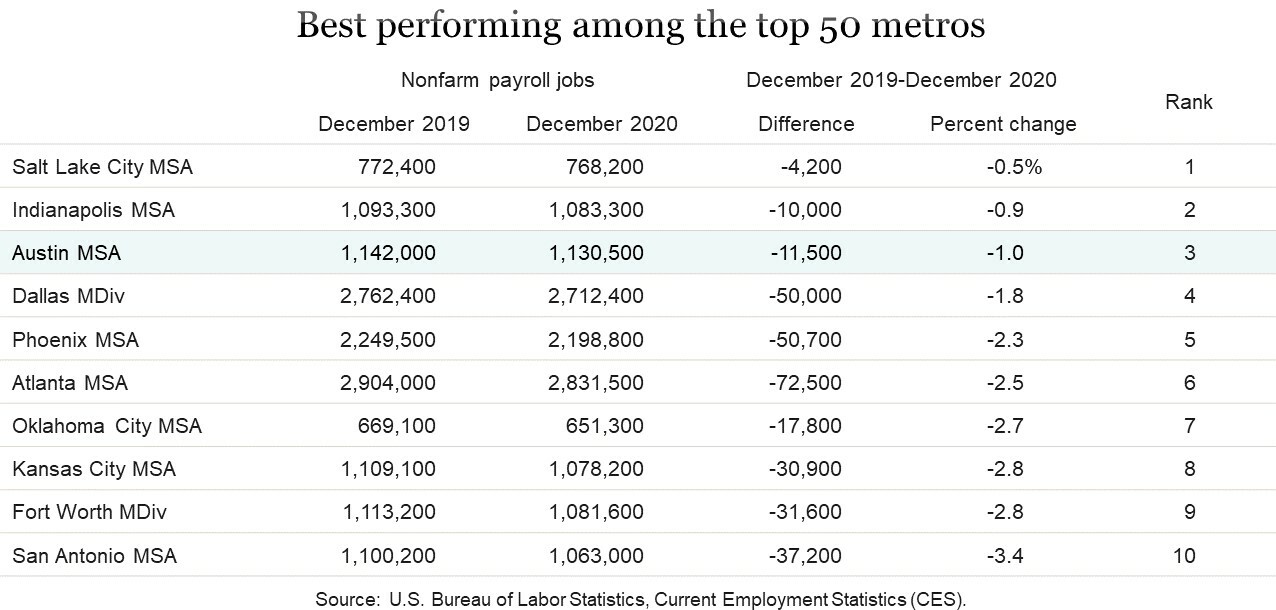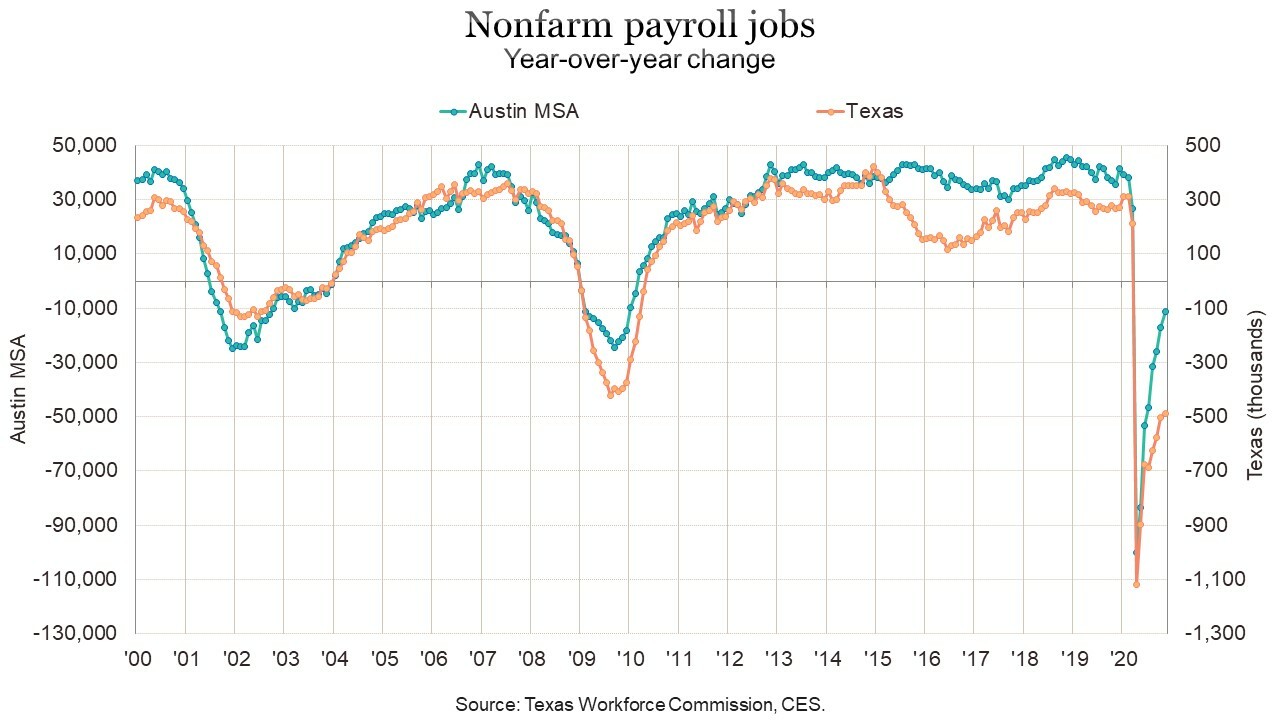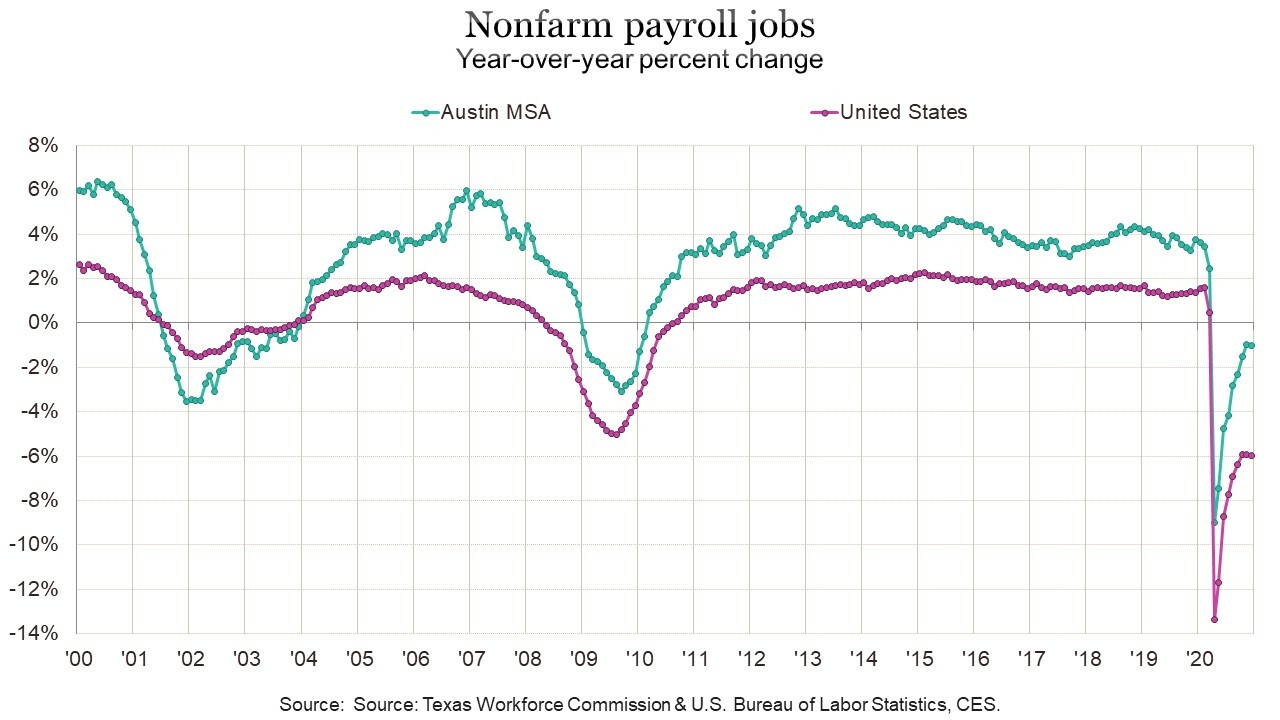Job growth & unemployment
Sign up for the Central Texas Economy Report newsletter
For opportunities with Austin employers currently hiring, see the Chamber's Austin Job Opportunities page.
Posted on 01/26/2021 by Beverly Kerr
- Austin added 5,600 jobs in December, narrowing pandemic-related job losses to 7,400.
- Austin’s 1.0% year-over-year job loss is more moderate than the declines seen in all but two other major metros.
- Austin’s leisure and hospitality industry added jobs in six of the last eight months. Nearly 59% of the 67,300 jobs lost in March and April have been regained.
- Austin's seasonally adjusted unemployment rate decreased from 6.3% in November to 5.7% in December.
Nonfarm payroll jobs
The Austin metropolitan area added 5,600 jobs in December, narrowing pandemic-related job losses to 7,400 according to Friday's releases of preliminary Current Employment Statistics (CES) payroll jobs numbers by the Texas Workforce Commission (TWC) and the U.S. Bureau of Labor Statistics (BLS).

Austin’s nonfarm payroll jobs total as of December is 1,130,500. In February, before the impacts from COVID-19, Austin had an estimated 1,137,900 jobs (38,000 jobs or 3.5% above the same month of 2019—an average trajectory for Austin in recent years). Combining job losses for March and April, Austin lost 128,600 jobs, or 11.4%. Positive growth in each of the last eight months has brought back 121,200 of those jobs.

Austin’s year-over-year decline of 1.0%, or 11,500 jobs, makes it the third best performing among the 50 largest metro areas. Dallas, Fort Worth, and San Antonio also ranked in the top 10. Houston’s loss of 4.4% ranks 16th. Four major metros—New York, Newark, Detroit, and Warren—remain down by more than 10% compared to December 2019.
For the year ending in December, private sector job loss in the Austin MSA is 0.6%, or 5,700 jobs, with losses occurring in five of the 11 major private industry sectors. Total job losses were 1.0% because Austin's sizable government sector (17% of jobs) shrank by 3.1% or 5,800 jobs.

Texas saw net private sector job losses of 3.5% with all but three private industry sectors losing jobs over the last 12 months. Total job losses were 3.3% as the government sector, which accounts for 15% of total state employment, had slighter losses (2.4%). For the nation, private sector losses were 6.1% for the 12 months ending in December with all private industries losing jobs. Overall job loss was 6.0% as government sector’s losses were relatively moderate (5.5%).

Jobs in December are up by 5,600 jobs or 0.5% from November in the not-seasonally-adjusted series for Austin. In the seasonally adjusted series, jobs increased by 4,800 or 0.4%. Seasonally adjusted jobs are up by 0.9% in Dallas, 0.8% in San Antonio, 0.5% in Fort Worth, and 0.4% in Houston. Statewide, seasonally adjusted jobs are up 64,200 or 0.5%. Nationally, seasonally adjusted jobs are down from November by 140,000 or 0.1%.

In Austin, six private industry sectors have positive growth over the last 12 months, most notably financial activities (17.1% or 11,600 jobs), followed by manufacturing (8.3% or 5,200), transportation and warehousing (7.5% or 1,900), and professional and business services (5.2% or 10,600).
The greatest number of job losses, and greatest percent change, over the last year happened in leisure and hospitality (19.9% or 27,300 jobs). Information also saw a double-digit loss (10.7% or 4,200) and education and health services is also notably down (4.1% or 5,400).

Additional graphs – New/lost jobs by industry: February to December and November to December
Compared to our last pre-pandemic month, February, five industries have lost jobs and seven have gained. Financial activities, up 17.4%,[1] and transportation, warehousing and utilities (11.0%) lead; followed by manufacturing (6.6%) and professional and business services (6.4%). The most notable losses over the last 10 months are in leisure and hospitality (20.1% or 27,600 jobs), information (10.2%), education and health services (4.5%), and government (4.4%).
Leisure and hospitality added back 39,700 jobs over the last eight months, reducing what had been losses of 67,300 jobs (-48.9%) in March and April. As of December, employment stands at 109,900. The last time Austin’s leisure and hospitality industry had a similar level of employment was early 2015. [2]

Statewide, over the last 12 months, only three industries added jobs. Transportation, warehousing, and utilities; professional and business services; and financial activities are up 3.4%, 1.9%, and 1.0% respectively. A double-digit loss prevails in leisure and hospitality (12.6% or 175,300 jobs). Also notably down are construction and natural resources (7.4%) and wholesale trade (6.2%).
Nationally, no industries added jobs over the 12 months ending in December. The largest percent change occurred in leisure and hospitality (22.7% or 3.74 million jobs), followed by information (8.8%), and other services (7.4%). Transportation, warehousing, and utilities is the best recovered industry with jobs only 0.1% lower than they were a year ago. Financial activities deficit of 0.7% is the next lowest.

Over the last 12 months, the net loss for private service-providing industries in Austin is 11,800 jobs, or 1.4%. Employment in goods producing industries is up by 6,100 jobs or 4.5%. Statewide, private service-providing industries are down 281,700, or 3.1%, and goods producing industries are down 105,600, or 5.4%.
Between November and December, Austin’s private service providing industries added 7,400 jobs or 0.9% and goods producing industries added 3,200 jobs or 2.3%. Statewide, jobs increased by 65,400 or 0.7% in private service providing industries and by 4,000 or 0.2% in goods producing industries.
An alternative version of seasonally adjusted nonfarm payroll jobs is estimated by the Federal Reserve Bank of Dallas. Annually, the BLS/TWC revise the sample survey-based CES series by benchmarking the estimates against the Quarterly Census of Employment and Wages (QCEW). The Dallas Fed “early-benchmarks” CES estimates against QCEW each quarter, instead of annually. QCEW has delivered payroll jobs data through June and the Dallas Fed series now takes account of this data. The BLS/TWC series, which was benchmark-revised in March, is informed by QCEW data only through September 2019.
QCEW gives a representation of March and April losses, but only two months of the recovery. Given the unprecedented nature of this recession it may be early days to begin second-guessing the performance of Texas’ labor markets as represented by monthly CES estimates, but Texas’ recovery looks somewhat less robust in the Dallas Fed version of this data. Comparing year-over-year change in the seasonally adjusted Dallas Fed series to the seasonally adjusted BLS/TWC data, Austin is down by 34,415 jobs or 3.0% in December instead of 11,100 jobs or 1.0%. Similarly, Texas has 4.5% fewer jobs according to the Dallas Fed, compared to 3.3% in the preliminary BLS/TWC estimates. A deficit of 3.0% for Austin would still be strong enough to be among the top 10 performing major metros this month. The Dallas Fed series has Austin losing about 5,100 more jobs in March and April than the BLS/TWC series and having thus far regained 73% of the lost jobs instead of 88%.
Labor force, employment & unemployment
We also now have December labor force, employment, and unemployment numbers for Texas and local areas in Texas. The same data for all U.S. metros will not be released until February 13. In November, Austin had the 22nd lowest rate of unemployment among the 50 largest metros. Across Texas’ major metros, seasonally adjusted December rates are below November by between 0.6 (Austin and Fort Worth) and 1.0 (Houston) percentage points.

In December, Austin’s not-seasonally-adjusted unemployment rate is at 5.1%, while the other major Texas metros range from 6.2% in Dallas to 8.0% in Houston. San Antonio and Fort Worth are at 6.4% and 6.5% respectively. Austin’s rate one year ago was 2.4%. The rates in the other major Texas metros are elevated from a year ago by 3.3 to 4.4 percentage points. The statewide rate is now 7.1%, up from 3.3% in December of last year. The national unemployment rate is 6.5%, up from 3.4% a year ago.

Within the Austin MSA, Williamson County has the lowest unemployment rate at 5.0% in December, while Caldwell county has the highest at 5.8%. The rate is 5.1% in Travis County, 5.2% in Hays County, and 5.3% in Bastrop County.
On a seasonally adjusted basis, Austin’s December unemployment rate is 5.7%, down from 6.3% in November. The statewide rate is 7.2%, down from 8.1%, and the national rate is 6.7%, unchanged from November.
In the aftermath of the dot-com bust, the highest seasonally adjusted unemployment rate reached in Austin was 6.1%. In the Great Recession, the highest rate was 7.5% and rates over 7% prevailed for 12 months.
Among Texas’ other major metros, Dallas has the next lowest seasonally adjusted unemployment rate, at 6.5%, in December, while Fort Worth is at 7.1%, San Antonio is at 7.2% and Houston’s rate is 8.1%. Seasonally adjusted unemployment rates for Texas metros are produced by the Federal Reserve Bank of Dallas. (The TWC also produces seasonally adjusted rates for Texas metros, but publication lags the Dallas Fed’s data.)

In February, before pandemic impacts, the number unemployed in Austin was 33,432 (very close to 2019’s annual average). The number climbed to 138,785 in April. In December, unemployed stands at 65,047. That level is 115% above the level of one year ago.
The Austin metro’s civilian labor force (employed plus unemployed) fell by 128,719 persons or 10.2% from February to April, while persons employed decreased by 234,072 or 19.0%. Labor force now stands at 0.2% above what it was in February and employed is estimated at 2.4% below. Compared to one year ago, labor force is 1.0% higher and employed is 1.9% lower.

Additional graphs – Labor force & employment: Texas and United States
Texas’ employment is 558,394 or 4.1% below last December, while labor force is essentially unchanged (-0.2%). Thus, the number of unemployed increased by 536,601 or 114%. Nationally, December civilian labor force is down by 4.0 million or 2.4% year-over-year, while employed is below the level seen in December 2019 by 8.9 million or 5.6%, and 4.9 million more people (89%) are unemployed.


The TWC and the BLS will release January estimates on March 12.
The Chamber’s Economic Indicators page provides up-to-date historical spreadsheet versions of Austin, Texas and U.S. data for both the Current Employment Statistics (CES) and Local Area Unemployment Statistics (LAUS) data addressed above.
FOOTNOTE:
- Monthly CES data provides limited industry detail for the Austin metro, but strong growth appears to be occurring throughout financial activities, with the exception of insurance, which has grown only slightly (3% or 500 jobs). About 40% of the financial activities jobs added over the last 12 months appear to come from the “securities, commodity contracts, and other financial investments and related activities” industry. The financial activities sector is made up of finance and insurance (67%) and real estate, rental, and leasing (33%).↩
- Pre-pandemic, about 78% of Austin’s leisure and hospitality industry jobs were in food services and drinking places and, in December, the share is 82%. Losses since February represent 16,700 jobs (15.7%) in food services and drinking places and 10,900 jobs (35.4%) in accommodation and the remainder of leisure and hospitality.↩